
Back to Homepage

Click Here to dialogue
with others about
these subjects.
 Back to Homepage |
|
CALENDAR HOUSE
1
Matching Discoveries
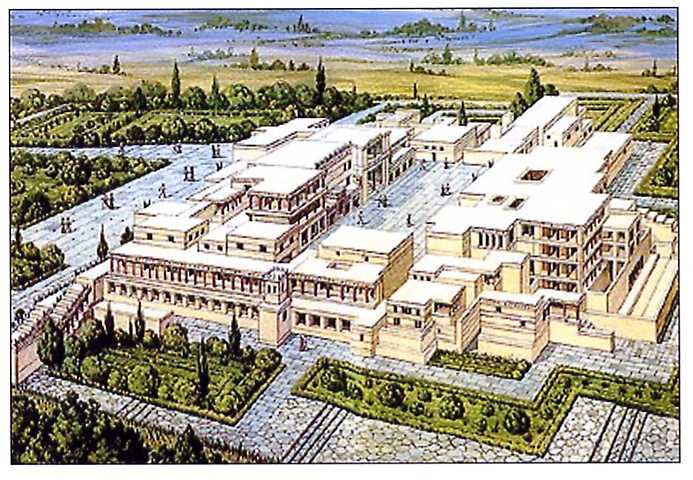
Minoan Crete and the Labyrinth of Knossos returned to the sun about 100 years ago. Thanks to Minos Kalokairinos (a Cretan who first dug there in 1878-79) and Sir Arthur Evans’ beginnings in 1900, the next century of archaeology unfolded 2000 years of Minoan achievement in every aspect of civilization. And, although the Minoans’ long dynamic story was affected by the Thera Volcano disaster and by the mainland’s Mycenaeans (or early Greeks), research continues to reveal Minoan cultural roots, survivals and influences across the Mediterranean, from the Neolithic to the days of The Bible and Olympic Games.
If Knossos Labyrinth was Crete’s symbolic and ceremonial center for at least 500 Minoan years (Driessen and McDonald 1997: 74), what kind of calendar served to organize their relationships with Crete’s ecological cycles and the cosmos? For a century of study, no central calendar has come to light to suggest how Minoans experienced and expressed their relationships with time.
As early as 1920, Nilsson’s Primitive Time-Reckoning collected then-available evidences about early Greek calendrics, but the later Classical lunar/solar cycle of 8 years---the octaeteris, from which derived the “half-cycle” for Olympic Games every 4 years---presented very little Bronze or Iron Age evidence of its roots. Clues from closer to the Minoans appeared in the 1950s, when Michael Ventris and John Chadwick deciphered clay tablets inscribed in the palaces of their Mycenaean mainland successors, and revealed the names of several months of their ritual year. Since then, however, those clues from outside Crete have not answered much of the mystery.
Research into Minoan astronomy has sparked since the 1990s, based in cultural comparisons with Egypt and the Near East, in direct observation with high-tech help, and in new awareness of the importance of sacred landscape in ancient societies.

For example, since at least 1993 Sweden’s Goran Henriksson and M. and G. Blomberg have been putting the text-based clues to work investigating the actual alignments of Minoan sites. Through 2008, they have demonstrated calendric relationships between ceremonial places and structures and the sun, moon and/or stars: for example the peak sanctuary closest to Knossos (Mount Juktas), sites further south at Vathypetrou and Phaistos, and recently two in the eastern town of Gournia.
Peatfield (1984, 1994), Driessen (2001) and Sarris et al (2002) have applied GIS or Global Imaging Systems to study relations between Minoan peak sanctuaries and palaces. In the midst of these sites’ interconnected “viewsheds,” they locate a likely “network of sacred beacons” that might have facilitated a “ritual unity beyond political boundaries”: a system that might have been part of a Late Minoan “centralization of state-controlled religion” (Peatfield 1994: 4, 25). Chapters 7 and 8 here explore how these might have been part of a Minoan calendric system.

MacGillivray (2004, 2007) has compared Egyptian calendric traditions with possible Minoan ones---from new ways to understand Crete’s symbolic “bull’s horns” or “horns of consecration” as a device for tracking the sun, to possible uses of the Decans stars as daily and seasonal guides. In 2008, Greek scholar Emilia Banou’s thorough investigation of Minoan “horns” also pointed to a solar aspect in Minoan religion. And in 2009 Finland’s Marianna Ridderstad published a 42-page survey evaluating every known clue to Minoan astronomy. While she found indications of yearly festivals at spring and autumn equinox, Ridderstad detailed as well that an 8-year solar cycle (and perhaps another octataeris, concerning star Spica and planet Venus) seemed to have a central calendric significance (26-27). Most research on the subject (including R.F. Willetts’ 2004 Civilization of Ancient Crete, 126) finds itself addressing a Minoan 8-year cycle of some kind.

Ridderstad cites a dissertation on at least 167 artifacts---flat and standing stones incised with “cups,” tiny sealstones, plaques, ceramics---featuring what appear to be more Minoan calendric clues according to several aspects, including clear visual references to sun/moon/stars, numbers of each feature, their arrangement-patterns, and features that appear to align with or correspond to actual events and cycles of heavenly bodies. Kyriakidis’ 2005 “Unidentified Floating Objects” closely examines Minoan seals along these lines, and his evidences suggest that “Minoans had a system of constellations that they depicted at times in relation to ritual” (153).
So far it appears there were multiple kinds of calendric devices and symbols in use or development across Minoan space and time. The most demonstrable evidence so far of a central and sanctioned Minoan calendar came to light in 2001.
Britain’s Lucy Goodison, in “Perceptions of the Sun in Minoan Ritual,” revealed unmistakable calendric concerns in the Throne Room of Knossos, in the Labyrinth’s west wing. It seems likely that calendric understandings inscribed there by Minoans had a long central significance in their civilization.
Arthur Evans found the throne of Knossos Labyrinth in 1900 (photo below in Brown).


This is the original throne today, in restored surroundings in the Labyrinth’s west wing. What Lucy Goodison discovered is immediately clear, below, from this detail of her diagram and her photo of the Knossos throne room.

Goodison’s diagram and photo show the throne positioned to be touched by the sun’s rays on winter solstice. Minoans positioned this seat in space according to time.

Every calendar must designate a moment from which to count days, months, years and cycles at all. Why winter solstice?
Astronomer Michael Hoskin’s 2001 Tombs, Temples and Their Orientations (17-19):
No one doubts the great significance for prehistoric Mediterranean peoples of the winter solstice. As the solstice approached, the sun’s rising point had for almost six months been moving south along the horizon, and of late the days had been getting alarmingly short and gloomy. Unless the sun called a halt and reversed the movement of sunrise, darkness and cold would take over, and human life would cease. Happily, at the solstice, and no doubt in response to ritual appeals, the sun did stop its alarming southwards progress and began its return with a promise of a new year. The Romans celebrated this with the feast of Sol Invictus, The Unconquered Sun…. We can be sure that winter solstice was of great concern to the peoples whose structures we study, because of its decisive importance to the continuation of human life. The summer solstice, the equinoxes, the major and minor lunar standstills, may possibly have been of interest to our monument builders….
The throne’s alignment might place it at the root of evidence that points to a Minoan winter solstice New Year. At present, scientific scholars at work on the later Antikythera Mechanism remark that its knowledge seems to come “from nowhere” (Bitsakis in Nature). But there are long-standing clues to review.
John Chadwick, an authority on Minoan and Mycenaean language and records, remarks that evidence from the post-Minoan mainland palace of Pylos “suggests Winter Solstice as a more likely [New Year] point” than any other, though mainland sites “did not always” do so (1976: 189, 97). Immerwahr’s 1990 study of Aegean frescoes (for one example) points to close links between Knossos and Pylos.
From Blomberg and Henriksson’s 2005 and 2008 works, we learn that eventual Mycenaean cultural dominance pointed to changes toward a preference for alignments with autumn and the west. Yet, Nilsson’s Primitive Time-Reckoning (1920: 315) shows that in the next-known evidences, from post-Mycenaean times---Homer’s Odyssey Book XV, and Hesiod’s Works and Days (564, 663)---the Solstice “houses of the sun” were well-recognized, and that Hesiod (circa 700 BCE) “reckoned time from them in days.”

Aristophanes in The Clouds (circa 423 BCE) berated officials “running [calendric systems] up and down” so that practical and religious orders of affairs grew chaotically out of step with sun, moon and each other. As Timaeus reported by about 300 BCE, magistrates had taken over from astronomers and were resorting to arbitrary declarations of patched-in time (intercalations, a custom whence we derive leap days).
While the Athenian (Attic) calendar eventually adopted an 8-year lunar/solar octataeris that began with the noumenia or New Moon after Summer Solstice, other city-states and neighbors (Boeotia and the isle of Delos, for example) remained anchored in a winter solstice New Year. Eliade (History) and Kerenyi (Dionysos) compare the different systems, finding the winter solstice one older and preferred (Kerenyi 299). If calendric progress was made in Athens, the Attic calendar’s insertion of “extra” 13th months, to make up for lunar/solar differences, pointed to problems and still resulted in errors (see Samuel’s Greek and Roman Chronology: we too must return to this).
Last in this chronology of clues, we have 2008’s high-tech study of The Antikythera Mechanism, whose clues (the authors write) point to a first New Moon “following solstice or equinox” by about 100 BCE (Bitsakis).
Another part of Goodison’s discoveries showed that Minoan tombs and cemeteries align with the east and sunrise, and roughly as many align toward equinox as toward solstice. She called other throne room doorway-alignments “days of the dead” (80) and found these indications of ancestral importance (Chapter 7). As her diagram shows above, the central anteroom doors pass light straight into the throne room’s inmost chamber, from which (according to Niemeier’s 1987 study), a “Priestess Queen” appeared during ceremonies. This is a central alignment of light that might argue for a Minoan equinoctial New Year.

Koehl also locates important Minoan rites in autumn (2001: 241), his basis being the later historical-period Cretan and Near Eastern systems whose New Year was near autumn equinox, timed with the approach of winter rains. Blomberg, Henriksson and Ridderstad have also studied calendric devices relating to spring and autumn equinox, and while they cannot be overlooked, this chronology of clues and the long primacy of the Knossos throne suggest an increasing degree of departure from calendric tradition connecting New Year Day with winter solstice. Perhaps some revelation in early Greek calendrics is around the corner, but for the present, there simply is no place more likely than Crete to yield central clues or discoveries.
Minoans could hardly choose a more central place than the Knossos throne to signify their beginning of time. Inscribed in the throne’s front face is perhaps another clue, what Ridderstad calls “an arc resembling the moon sickle” (26).

Is it likely that this “arc” is only to simulate a wooden chair’s bracing? It is nothing like the long narrow square-edged bracings cut into the lower throne’s two sides, which do seem to imitate a wooden chair’s support-frame. (You can see this on one side in this chapter’s final image of the throne.) If the sign above is more than decorative---and this is hardly a place for mere decoration---an “arc resembling the moon sickle,” then, might be a New Crescent Moon. As we’ll see by comparative examples of this figure below, a disc in or above a crescent is usually understood to represent the sun and/or a star.
First, here are other Minoan examples found by this research of what scholars such as Crowley (1989) call the “star disc in crescent” or “crescent and solar disc.”


At left is an incised bronze plaque from Tylissos, and beside it, a jug from the Knossos “House of Frescoes”: the plaque dates from Middle Minoan centuries and the jug from Late times, but both were contemporaries of the throne. On the Late jug, a Labrys or double axe forms the crescent that flanks the disc (much more ahead about Labrys and this motif). In the Tylissos figure, it seems obvious that a sun appears to rest in a kind of “lunar boat,” as in the ancient Egyptian conception of the soul’s journey after death (Chapter 7). We almost have to find symbolism involved, for the sun virtually never forms such a configuration with the moon. Yet, the solar and lunar reference seems to remain. Later we’ll return to these objects.
Below at left is a detail from a small, likewise Late ceramic mould found near Sitia, whose figure centers around the cross (almost a universal symbol of the sun) with a crescent underneath it. Below at right is an undated, likely-Late Minoan sealstone (both objects in Goodison Women Figs. 132b, 138a): its crescent is formed by a doubled pair of serpentine bull’s horns. Sickle, crescent, lunar boat, double axe, horns: this kind of visual allusion or family of visual puns informs the last example as well.
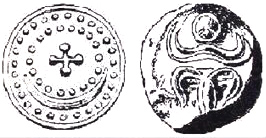

This painting, a fragment from the wall of the tomb of Senenmut (a Vizier of Queen Hatshepsut’s), shows Minoans bringing gifts and trade to a Pharaoh’s court (in Culican, Fig. 41). The central cup shown oversized by the artist is clearly a Late Minoan type called a Vapheio Cup (Evans Palace of Minos 2: 534; Driessen/Macdonald Troubled Island 80). The painted image on it presents again the disc-in-crescent figure, in a context of “royal” relations. At the time of its delivery, the Knossos throne was already at least 300 years old. In connection to calendric evidences presented in chapters ahead, note that the image is doubled, and rendered in blue and orange.
Perhaps the Egyptian witness and/or artist got the Minoan decoration wrong. Perhaps he/she changed colors, or added a solar disk to a mere brace of Cretan bulls, because according to Banou (31) this very motif was then a current New Kingdom one. For that reason the doubled bulls might have nothing to do with Crete, but instead be a type to please Pharaoh. Yet, both cups’ details are almost photographic, and Marinatos (2010: 117) accepts their motifs as Minoan.
While the “House of Frescoes” jug above has many Late-period cousins (Chapters 7-8), these are all the examples known to this study contemporary with the Knossos throne. In a way, Crowley’s judgment holds true (The Aegean and the East, 277):
The Star Disk in Crescent, and all the associated celestial symbols so popular in the Mesopotamian tradition, find no real acceptance in Aegean art except in a few signets….This, in spite of their ubiquitous presence in cylinder seal designs, can only indicate that their symbolism is of little use to the Minoans and Myceneans….[The] motifs never take the step on from Intrusive Element to Incorporated Element, and thus never become fully accepted into the Aegean artistic tradition.
And yet, there it is: the disc-and-crescent in the Minoans’ central seat of power. Late Knossos produced many more examples and variants, treated in Chapters 6-9.
Can we discover more of this sign’s meanings from foreign examples?

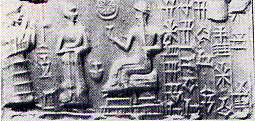


At bottom-left---among these details from Old Babylonian and Sumerian seals---is the tall stele of Ur-Nammu, dedicated to the god Sin. Sin was a monthly “judge of the underworld,” “father of the gods” including the sun, and a “shepherd of the stars,” whose crescent-moon was “most frequently” linked to the horns of a bull (Green 1992: 25). According to Crowley’s Aegean, the disc-and-crescent is “pervasive” in Mesopotamian traditions, presiding over “ritual or mythological scenes” (125). Next to the Sin stele we notice that, in the Babylonian seal found near Heraklion dated by Evans to about 2000 (Palace 2: 265), the circle-and-crescent symbol is a near-match for the one from Sitia (shown above) with its 4-point cross at center.
Among the oldest examples is the Cappadocian seal below at left, from about 2400 BCE (Palace 3: 205), whose disc encircles a cross; while the plaque from Sumer at right (c. 1700) shows the goddess Ishtar wielding the sign on a sceptre.

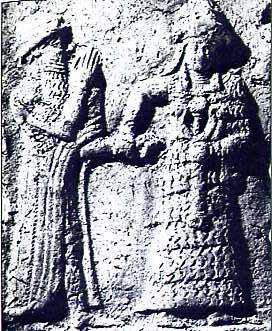
The details from seals below reflect the disc-and-crescent’s borrowings in the later Near East. The scene at left came from Anatolia (1850-1750 BCE). At center and right are Old Syrian examples, also after 2000 BCE: all from Marinatos’ Warrior (4, 34).

A “Syro-Hittite” example is below at left. Beside it is a Middle Bronze Age Hittite seal found in Israel (which, for Singer, typified “the sun discs and moon crescents mentioned in Hittite texts”: 2006, 739). Third below is a standing stone from the central shrine in the city of Hazor. Minoan traders, diplomats, artisans and others were in contact with all these culture-regions over long periods. Along with cultural exchanges, the disc-and-crescent likely migrated eastward to the Levantine coasts and, at last, to Crete. Wooley’s 1950s excavations at the trading-center of Alalakh in Syria found “Middle to Late” Minoan frescoes there, including “a bull’s head” with either a disc or double axe between the horns (Cline 1995: 269; Niemeier 1998: 83).



One last Near Eastern example (below) is a detail from a Cypro-Mycenaean cylinder-seal (from Evans’ Cult 71)---dated from post-Minoan times when Cretans, Mycenaeans and others were settling in Cyprus, and whose disc-and-crescent figure signified, for Evans, “a combination of solar and lunar divinities.”
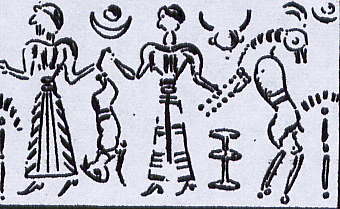
How would symbols of moon, sun and stars “preside” over ritual ceremonies? In these images, the symbol(s) might only mean the rituals were held outdoors by day and night, or in a temple of the sun and/or moon. Turning the great visible events of nature into elements of ceremony, however, was all to the benefit of leaders claiming divine sanction. Compelling ritual had to be harmoniously timed to the natural and religious year, a prime function of a calendar---keeping food-production labor, festivals and religious (official state) activities in time with seasonal, solar and lunar real cycles. The disc-and-crescent figure, then, might signify calendric meanings as well.
What about Egyptian examples? Minoans were known at the religious center of Abydos, for example, since at least the Twelfth Dynasty---from at least the 1900s BCE, or Middle Minoan times (Culican 28: see also O’Connor’s 2009 Abydos).

![]()
Above (left) is Martin Isler’s diagram (2001: 44) of a “Min hut” or shrine---a very early structure that combines Near Eastern aspects with Egyptian ones, to signify and facilitate the worship of Min---who as a god of “fertility” had many traits in common with Sumerian Sin (above: see Marinatos Religion 183 for Minoan connections). The “bull’s horns” at the top of the “mast,” Isler argues, developed from a simple “bifurcated stick or gnomon,” used in very early times to track and measure the sun’s course: a calendric function, and hence the “sun symbol” between its arms. At right above, perhaps coincidental in form, are the Egyptian hieroglyphs for “New Year” and “New Year’s Day” (see Budge 1920, Bromiley 1982, and Gardiner 1957); which seem to be family with the disc-and-crescent figures shown.


At left above, the lower crescent is the Egyptian hieroglyph djew, meaning “horizon”---with reference to the hills and mountains “holding up the sky” that flank the Nile River Valley, and to the “wilderness” or “land beyond,” where Egyptians buried their dead. (The ancient association between “mountain” and the dead will prove very significant in later chapters.) MacGillivray’s 2007 “Twin Peaks” argues that Minoans had the djew and solar astronomy in mind when erecting and inscribing what were long called “bull’s horns”: see also Banou’s history of the controversy.
With the disc added above the djew crescent, it becomes akhet, meaning “horizon of the Aten” (or, the sun); referring to both its rising and setting, its cyclic journey from life to death and life again in its “boat of a million years.” (Hence a possible connection to the Tylissos Plaque above.) The guarding aker lions were called “Yesterday and Today,” and fulfilled the same functions as the mountains and the goddesses’ arms shown below: they were the sun’s protectors “at either gate of the dark tunnel of the Underworld, through which the sun passed between nightfall and dawn” (Evans qtd. in Bloedow 302). These meanings are confirmed in many Egyptian examples; as in this tableau of “the birth of the sun” from a Pharaoh’s tomb that continued these traditions long after Minoan times (circa 1150 BCE: in Baring 258).

The horned crowns (below) of supreme goddess Isis, of Hathor the cow-goddess, and of Taweret (whose realm was among the Egyptians’ “imperishable stars,” Chapters 6-7) seem to confirm that the disc-in-crescent or between “horns” was a representation of (at least) the sun.


Ahead, we must remember that the disc had reference to both the sun and a star or stars. In Egypt, both symbolized in part the human soul, in its Underworld/Afterlife journey (the sun) and in its eternal abode among stars.
The disc as sun, then, has practical calendar-related meanings as well as religious and spiritual ones. In the same way, the disc as star(s) refers to actual stars and to the realm of eternity beyond this life. This is consistent with the meanings of djew and akhet as literal “horizon” and as “horizon” of this life; for horns can signify “the gate of the cosmic mountain” as the abode of the dead, and are “morphologically cognate” with it, “nearly interchangeable” (Marinatos 2010: 67, 116).
Henri Frankfort’s 1948 Kingship and the Gods speaks to this ambiguity (120):
The dead were not thought to inhabit a static Beyond, but to move with the sun and stars….In other words, it is futile to expect a given region to be consistently regarded as the abode of the dead, since they participated in the cyclic movements of nature….[The dead] were in the Netherworld as well as in the night sky, and by day were in the boat of the Sun.

As Isler’s diagram shows (112), so were the Pyramids aligned with both the daily and annual cycle of the sun, and with northern (and southern) stars. Ahead is evidence that the Knossos throne shares these designs. For all that research has shown of Minoans learning (selectively) from Egypt, such alignments might not surprise. Frankfort (150) finds “the concepts of creation, sunrise, and kingly rule…continually merged” in Egyptian language: the same verb that “marks the appearance of Pharaoh on the throne” also denotes sunrise, and “is written with the hieroglyph that depicts the sun rising over the Primeval Hill.” Based in Sumer and Egypt, his note (380) reminds that this was so where “New Year’s Day was the anniversary of creation.”
The Labyrinth’s symbolically-central seat appears to be aligned with winter solstice as a marker and partaker of the sun’s annual rebirth. Hence, it seems the likely anchor for a Knossos calendric conception of the sun’s cycle; possibly, a conception as central to Crete as the throne that expressed it.
For the present, we can make a further deduction that might in turn help us to see more clues before our eyes. If the disc on the throne represents the sun, and the sun at its cyclical “birth,” we can be almost as sure that the “arc” or crescent below the disc represents the New Crescent Moon (the ancient priesthoods’ “first visible crescent”)---which is the lunar phase that matches and complements the phase of the sun at its own (winter solstice) return from a year’s cyclical dark extreme.

Possibly, Minoans emphasized instead the “waning into dark” phases of both sun and moon, which come just before winter solstice and monthly rebirth; and so the lunar arc on the throne is a not a New but a Waning Crescent Moon. That would be consistent with noted suggestions of a Minoan New Year in autumn and equinox alignments. How, though, would those indications work with the throne’s alignment, and with evidence to come? The crescent might also mean both New and Waning Moon. The final section of Chapter 3 attempts to address these issues.
What seems clear is that the crescent and disc represent, as in other cultures, the moon and sun. Evans’ phrase cited above---a “combination of solar and lunar”---points to a complementary relationship between them. As noted about the bronze plaque from Tylissos, it is not likely that they represent a configuration of sun and moon ever seen in the sky. It is too rare (if possible) to be the anchor of a serviceable calendar.
Is there a real cyclical moment in nature when these New Sun/New Moon phases coincide, and can be observed together---like a reconciliation of lunar and solar time? That “problem” of the difference between solar and lunar cycles is a central concern of every calendar.
Such a cycle exists. It was visible in Minoan skies, and continues in our own: it ended and began anew at Winter Solstice 2009 (AD).
First as we go forward with an observation chart (below), note that the date of each year’s winter solstice varies about equally over centuries between 12/20 and 12/21. For clarity, this study selects one (12/20) as its date. The near-equal long-term variations cancel each other out of the results without losing an accurate description of nature.
As you see from the chart---created by simulated direct observation with SiennaSoft’s well-reviewed computer-astronomy program, Starry Night---a New moon’s first visible crescent appeared on 12/18/2009, and it was growing in the sky through winter solstice (12/20 in each entry).

All features will be clarified quickly. This 2009 New Crescent Moon---marked with a red bullet, like other New Moon/Winter Solstice examples---remained a “sickle” in the sky till it reached First Quarter (its 7th day), when its “horns” became the straight line of light-and-shadow that looks like a half-full moon. In today’s 8-phase synodic cycle of the moon, a moon is “New” through its first 7 days up through this point.
(The moon’s “half-full” look at First Quarter is deceptive, for the first of two nights of Full Moon was then only 6 days off---the first Full night of a moon being its 13th, another important calendric number as we’ll see.)
The chart’s most precise example of this New Moon/Winter Solstice “reunion” of lunar/solar time is 8 years forward---at Winter Solstice 2017, when the first visible New Crescent Moon appears on Winter Solstice Day. Over long periods of time---“observed” for this study at every solstice from 2000-1300s BCE---this accuracy is more common than the sample reflects. The sample suggests how the cycle modulates: note that along 8-year intervals (2001, 2009, 2017), New Moon and Winter Solstice are trending toward exact reunion. There is more to know right away about exactitude. First, we see the observable reality of this lunar/solar event.
Sometimes a New Moon crosses Winter Solstice along a “string” of 4-year intervals. Each is a pentaeteris, as a 4th-year event that opens up a fifth year (this was the “half-cycle” governing timing of Olympic Games). Examples above include 2001-2006, and 2004-2009-2014.
Yet, by these observations, 12 of the 18 years in the sample feature some kind of New Moon/Winter Solstice crossing in the sky. We might expect so many because inclusiveness makes later judgments more reliable, and because a New Moon has 7 days to cross with Winter Solstice. To go forward, we must know why the chart bullets lunar and solar events up to 5 days apart.
Then (and next chapter, in direct evidence), we can begin to see the main observation criteria that may have helped Knossos observers to select and track the most accurate and enduring lunar/solar patterns among all these events---the 8-year pattern already supported by evidence and research (for example, Blomberg and Henriksson’s “Enneoros” and “New Trends”).
After all, look at the sample observation chart. By observing only forward in time, as Minoans had to, can we count forward from any bulleted point and find the 8-year interval? We try, comb our way through, compare, and---as with strings of pentaeteris events, which manifest and then fade over time---we find the answer No. This is another clue that observation criteria have to provide us with guides, for clearly such patterns exist.
Why 5 days as a New Moon/Winter Solstice criterion? The answer has roots in a problem for all calendars, and perhaps a Minoan response that stands registered in evidence from them.
A year is one full cycle of ecological seasons. Ancient Egypt centered on the Nile River’s cycle of Flood, Subsidence and Drought: a 3-season year. When the moon’s synodic cycles became Egypt’s “first chronometer,” and timed the festivals of its food-production year (as in most ancient cultures: Nilsson Reckoning 148), festivals soon “fell back in time,” or out of step with the solar or tropical year.
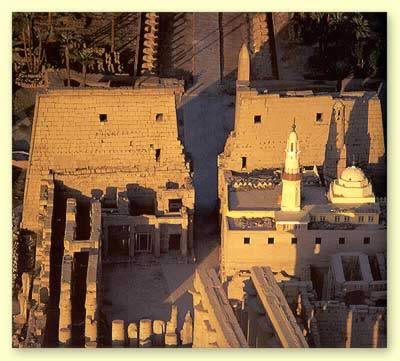
In other words, the cycle as divided into moons or months (29.53 days each), multiplied by a 12-moon cycle of the seasons (354 days), was falling out of step with the sun’s full cycle (365¼ days). The sun, in Isler’s experiment-based judgment (156), was Egypt’s most accurate calendric source. Their answer to this 11-day difference between lunar/solar cycles was to round the length of each month upward, from 29.53 to 30 days---effectively adding almost half a solar day (.47) to each month, for a yearly total of 360 days. In a sense, no matter what minor variations they observed, they “declared” a month that much longer for important reasons.
To make up the rest of the lunar/solar difference---the goal, to keep their work-related and religious festivals in time with the seasonal needs of food-production---ancient Egypt celebrated 5 epagomenal or “added-on” days at the end and beginning of each yearly cycle, which wove together (with the help of star Sothis or Sirius, plus the Decans) the real rhythms of the Nile, moon, sun, and their culture. In Bronze Age agricultural ages, these inventions or insertions of “patches” of human time were created to smooth over observed calendric problems. Intercalations were a workable and mostly-satisfactory resolution to balance civilization and natural facts.
In the same way, needing a workable calendar, we hardly notice a leap-day each 4 years. Given that last quarter-day in a sun’s complete cycle, which added a full day every 4 years, the roots of “leap day” traditions were also born.
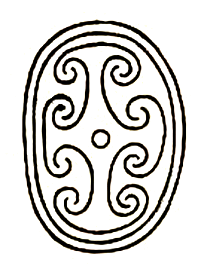
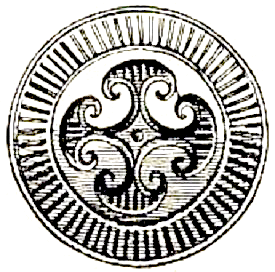
To sum up: Egypt’s calendric response to this lunar/solar problem was a 30-day month, a 5-day New Year festival and a leap day. There is, ahead, direct Minoan evidence of these same (adopted?) solutions to the problems of one calendric year. The reward for holding to that possibly-Egyptian prescription of 5 New Year festival days would be a useful one. A perhaps-surprising result was more long-term ability to track, predict and adjust to the most accurate strings of 8-year paired events, as more observation will show (and cultural contexts, Chapter 5). In the chart above, count any New Moon more than 5 days from Winter Solstice, and the cycle quickly fades from sky and time.
We need more than one observation criterion to begin to find our way in this astronomy. We have yet to address the other solstice alignment demonstrated by Goodison in the Knossos throne room---that of Summer.

In Goodison’s plan, Winter Solstice light passes from the southern anteroom door and the northern inner door to reach the throne (with its back to the north wall), striking the throne’s (upper) northeast side. Then in yearly alternation, Summer Solstice light enters from the north anteroom door and goes through the southern inner one, to reach the southwest corner of the “Lustral Basin” or Sunken Chamber opposite the throne on its dais. An X forms where the lines of solstice light conceptually cross, in front of the throne room’s central pier.
Why this Summer alignment? While Goodison speculates on its carefully-orchestrated ceremonial meanings and uses, we can see multiple interwoven kinds of complementarity and alternation in these spatial and light relations.
At New Moon/Winter Solstice (or, NM/WS), sun and moon are new-born. From that point they only wax toward extremes of their cycles. Those extremes, limits, and annual turning-points in their respective cycles are Full Moon and Summer Solstice, when moon and sun reach their peak and begin to wane back toward their beginnings. The throne anteroom’s 4 doorways place these phases in their outermost opposites.
Is there an equally real event that embodies this second complementary relation between moon and sun? How often does Full Moon meet or cross Summer Solstice? The observation chart below, presenting the same sample-years (and the same addressed variation in solstice dates), marks each of these events with a green bullet.

A Full Moon’s crossing with Summer Solstice is almost as common as New Moon at or near Winter’s. In Summer’s case---according to a Minoan criterion to be shown---these observations include all events within a 7-day window. In fact, we’ll see that Summer Solstice’s signs are less stable over time than its winter complements, and as such, are the best warning that a string of 8-year anniversaries will soon fade. (It happens soon after Full Moon “misses” the exact Summer Solstice by days even approaching 7 either way.)
As our goal is to recognize the most accurate and enduring lunar/solar signs of an 8-year cycle, how do these Full Moon/Summer Solstice crossings correlate with those of New Moon/Winter Solstice? The chart below presents the same sample-years with data toward answers.

Now we see only those New Moon/Winter Solstice events (red bullet) that precede and pair with a Full Moon/Summer Solstice (green bullet). What intervals and patterns emerge across the full sample?
At first sight, we find only 2- or 3-year intervals between each pair. Then we discover several pentataeris or 5-year intervals among pairs. For example, the pair at 2004/05 repeat at 2009/10, but then the pattern or “string” of them fades (at 2014/15).
A second 5-year interval between pairs endures longer, from 2007/08 through 2012/13, to 2017/18. But the only other regular repeating pattern among the sample’s pairs (and, which fits other evidences here) is an 8½-year year interval. In the sample above, there are 3 such strings of 8½-year pairs. They run:
A) from 2001/02, through 2009/10 to 2017-18; but, (by observation off the sample-chart), this string begins to fade at 2025/26;
B) from 2004/05 to 2012/13, which (by observation off the chart) is still accurately repeating in 2020/21; and
C) from 2007/08 to 2015/16, which is also still repeating at 2023/24.
When New Moon/Winter Solstice is followed directly (6 months later) by Full Moon/Summer Solstice, we find multiple overlapping chains or strings of the 8½-year interval shown above, and further on. The lunar phases on solstice-days along “String B” and “C” above are particularly close. Their crossings are either exactly on solstice or within 2-3 days for stretches of at least 24 years, with more in both directions.
As a pentaeteris marks a “4th year opening the 5th year” anniversary, this period marks an “8th year opening the 9th.” So this is actually an 8½-year cycle---manifesting a doubled pair of complementary lunar/solar events, one pair at each end and new beginning. New Moon/Winter Solstice, Full Moon/Summer Solstice.
We cannot know exactly which string of New Moon/Winter Solstice-Full Moon/Summer Solstice anniversaries that Minoans of Knossos tried to track in Bronze Age times. There is, ahead, evidence that they were tracking several such lunar/solar strings of their own day.
What we certainly will see is that this configuration---the doubled pair as the hallmark of a lunar/solar cycle---appears throughout the evidences in this work.
Obviously, questions remain. How could this cycle be used to mark daily, monthly and yearly increments of time? How did leading Minoans find their best calendric way when (as we see) these pairs of lunar/solar signs overlapped one another?
How did Minoans cope when the paired signs along a string faded out over time---when (for example) Winter Solstice presented its New Moon sign, but these were no longer answered by their countersign, Full Moon/Summer Solstice? How did they respond when these cycles returned to the sky, and ran for especially long and accurate periods? This also, study can illuminate.
It might be fair to call this cycle a Minoan Great Year. A “great” king, we are told, rules others: a “great” cycle includes others, as the Greeks’ later Metonic cycle takes in lunar, solar and eclipse periods. And this name can distinguish a Minoan “8 or 9”-year cycle (96 + 6 actual moons) from the later Classical octennium, which is 3 months shorter (96 + 3 inserted “extra” months). Other differences will appear.
By this point, we see that this “8 or 9”-year cycle is real; and that the Knossos throne presents more evidence of it, to close this chapter’s introduction.

Made of gypsum, once as white as Full Moon, the throne’s back-rest frames its occupant in four wave-like contours (inward and outward) on each side. Doubled, they total 8, and the wave across the top totals 9. By written tradition, “King Minos” ruled Crete from here by periods of 8 or 9 years---a solar king whose name invokes the moon, and a judge in the Underworld whose name is identified with Asterios, “ruler of the stars” (Apollodorus qtd. in Ridderstad 5).
While Marinatos (2010: 12) speaks for many scholars who view “the legend of King Minos” as “a mirror of Athenian social realities, not of Bronze Age Cretan institutions,” ahead we will see many Minoan clues of such a lunar/solar period.
There is much more calendric evidence to study in the Knossos throne room, with its aspects reflective of Minoan “interest” in the “dead of winter, high summer, and moments of movement and transition between” (Goodison 2001: 81). As Chapters 7-9 will show, there are structural parallels between Knossos as a “mountain” and throne with its alignments and symbols and the earliest peak-sanctuary centers of Minoan religion, situated between the sky and the ancestral underworld.
Goodison’s 2001 Winter and Summer Solstice demonstrations also speak to a Minoan calendric discovery achieved almost 40 years ago.

In 1972, American scholar Dr. Charles F. Herberger published The Thread of Ariadne: The Labyrinth of the Calendar of Minos. His evidences and demonstrations suggested that the uniquely complex border-design surrounding the famous “Toreador” or Bull Leap fresco, from the east wing of Knossos Labyrinth, presents symbols and patterns of a lunar/solar cycle, rooted in a Winter Solstice New Year.
Harvard University’s Dr. Alexander Marshack, reviewing Thread of Ariadne in 1974 for American Anthropologist, judged Herberger’s anatomy of the fresco “valid and valuable,” if problems and questions could be further investigated. Exploring possible answers to those issues (and more) became the purpose of this research, which began in 2005. (Full text of Marshack’s review provided in “Coda”: see also Chapter 3’s end.)
With our clues so far, let us look in new critical ways at the artifact first read afresh by Herberger---a fresco whose assumed decorations could be as observed and elegant a calendar as we might expect from Knossos.

***
 |
 Click Here to dialogue Click Here to dialoguewith others about these subjects. |
 |
| Back to Contents | On to Chapter 2 |